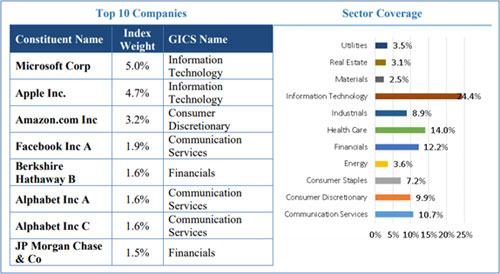Motilal Oswal S&P 500 Index Fund: An Overseas Venture Worthy of Your Risk?
Listen to Motilal Oswal S&P 500 Index Fund: An Overseas Venture Worthy of Your Risk?
00:00
00:00
In current pandemic situation with the lockdown and a disruption to the economy, the markets have caught the flu with coughing fits of volatility. Active management has become difficult for many fund managers and investors are distraught with their capital erosion.
Thus, actively managed funds seem to have taken a back seat for now. And Index funds are now being eyed to offer some relief. Several fund houses have launched passively managed fund, including Motilal Oswal Mutual Fund who has come up with Motilal Oswal S&P 500 Index Fund.
Index funds basically as per the categorisation norms are described as funds that will invest a minimum 95% of total assets of the scheme in securities of a particular index. They have a portfolio comprising of stocks of securities in line (weightage composition-wise) with that of the tracking index. This tracking is called indexing, a passive form of fund management.
Motilal Oswal S&P 500 Index Fund will track the world's largest benchmark index S&P 500 Index. This equity index contains stocks of top U.S. companies listed on one of the premier benchmarks for the U.S. stock market's performance.
Motilal Oswal is of the view that investing in S&P 500 index is helpful for the following reasons:
-
Immensely long track record of over 63 years
-
Vast Global exposure of the sales of S&P 500 constituents were reported from foreign countries
-
Very low correlation historically with Nifty 50 and Nifty 500 Indices, making it potential for diversification
-
The current correction in S&P 500 index, as per the valuation multiples (PE, PB and Div Yield) makes it an attractive investment option
-
Rupee depreciation against the US dollar, where the returns gained in Rupees will be higher
However, given that it is an offshore-dominated fund, the risk of investing in foreign securities, i.e. exposure of dynamic exchange rate fluctuations and geo-political risk, makes it extremely risky.
 Image Source: photo created by rawpixel.com - www.freepik.com
Image Source: photo created by rawpixel.com - www.freepik.com
[Read: Why Comparing Returns to Risk Is More Meaningful!]
Table 1: Details of Motilal Oswal S&P 500 Index Fund
| Type |
An open-ended scheme replicating / tracking S&P 500 Index |
Category |
Index funds- overseas |
| Investment Objective |
The Scheme seeks investment return that corresponds to the performance of S&P 500 Index subject to tracking error.
However, there can be no assurance or guarantee that the investment objective of the Scheme would be achieved. |
| Min. Investment |
Rs 500 and in multiples of Re 1 thereafter |
Face Value |
Rs 10 per unit |
| Plans |
*default |
Options |
Growth |
| Entry Load |
Not Applicable |
Exit Load |
|
| Fund Manager |
Mr Herin Visaria (Equity) and Mr Abhiroop Mukherjee (Debt) |
Benchmark Index |
S&P 500 Index (TRI) |
| Issue Opens |
April 15, 2020 |
Issue Closes: |
April 23, 2020 |
(Source: Scheme Information Document)
How will Motilal Oswal S&P 500 Index Fund allocate its assets?
The asset allocation pattern of the scheme would be as follows:
Table 2: MOS&P500IF's Asset Allocation
| Instruments |
Indicative Allocation (% to net assets) |
Risk Profile |
| Minimum |
Maximum |
High/Medium/Low |
| Equity and equity related securities covered by S&P 500 Index |
95 |
100 |
High |
| Debt and Money market instruments, overseas mutual fund schemes or exchange traded funds |
0 |
5 |
Low to Medium |
The Scheme may take an exposure to equity derivatives of constituents of the Underlying Index for short duration when securities of the Index are unavailable, insufficient or for rebalancing at the time of change in Index or in case of corporate actions or for hedging purposes, as permitted by SEBI/RBI.
The Exposure to derivative instruments shall not exceed 50% of the total Net Assets of Scheme. The Fund shall not write options or purchase instruments with embedded written options. When constituent's securities of underlying Index are available again, derivative positions in these securities would be unwound. Subject to the SEBI Regulations as applicable from time to time, the Scheme may, if the Trustees permit, participate in securities lending.
The maximum exposure of the Scheme to a single intermediary in the stock lending programme at any point of time would be limited to 5% of the market value of its equity portfolio or up to such limits as may be specified by SEBI. The Scheme will not lend more than 25% of its corpus. The Scheme will not invest in debt instruments having Structured Obligations / Credit Enhancements.
(Source: Scheme Information Document)
What will the Investment Strategy be?
The Scheme follows a passive investment strategy and invests in stocks in a proportion that is as close as possible to the weightages of these stocks in the respective index. The investment strategy would revolve around reducing the tracking error to the least possible through regular rebalancing of the portfolio, taking into account the change in weights of stocks in the indices as well as the incremental collections /redemptions from the Scheme.
A brief of the Index
The S&P 500® is widely regarded as the best single gauge of large-cap U.S. equities. There is over USD 9.9 trillion indexed or benchmarked to the index, with indexed assets comprising of approximately USD 3.4 trillion of this total making it the largest and most widely traded index in the world. The index includes 500 leading companies and covers approximately 80% of available market capitalization.
Index Attributes
Created in 1957, the S&P 500 was the first U.S. market-cap-weighted stock market index. Today, it's the basis of many listed and over-the-counter investment instruments. This world-renowned index includes 500 of the top companies in leading industries of the U.S. economy.
The S&P 500 is highly regarded as a proxy for the U.S. equity market and it is the only stock market benchmark serving as an economic indicator in The Conference Board Leading Economic Index. It has stood for U.S. stock market performance in that context since 1968.
Methodology
Universe: All constituents must be U.S. companies.
Eligibility Market Cap: To be included, companies must have an unadjusted market cap of USD 8.2 billion or greater.
Public Float: Companies must have a float market cap of at least USD 4.1 billion.
Financial Viability: Companies must have positive as-reported earnings over the most recent quarter, as well as over the most recent four quarters (summed together).
Adequate Liquidity and Reasonable Price: Using composite pricing and volume, the ratio of annual dollar value traded (defined as average closing price over the period multiplied by historical volume) to float-adjusted market capitalization should be at least 1.00, and the stock should trade a minimum of 250,000 shares in each of the six months leading up to the evaluation date.
Sector Representation: Sector balance, as measured by a comparison of each GICS sector's weight in an index with its weight in the S&P Total Market Index, in the relevant market capitalization range, is also considered in the selection of companies for the indices.
Company Type: All eligible U.S. common equities listed on eligible U.S. exchanges can be included. REITs are also eligible for inclusion. Closed-end funds, ETFs, ADRs, ADS, and certain other types of securities are ineligible for inclusion.
Image: Index composition
 (Source: Scheme Information Document)
(Source: Scheme Information Document)
Who will manage MOS&P500IF?
The foreign securities portion of Motilal Oswal S&P 500 Index Fund will be managed by Mr Herin Visaria and Mr Abhiroop Mukherjee will manage the Debt Component.
Mr Herin Visaria is a Fund Manager of Foreign Securities at Motilal Oswal Asset Management Company Ltd. He is a Commerce graduate from the University of Mumbai and has over 11 years of overall experience. He was associated with Motilal Oswal Securities Limited in Institutional Derivatives Research from Jan 2008 to Nov 2013, Religare Capital Markets Ltd in Institutional Derivatives Dealing from Dec 2013 to Aug 2017 & with Bank of Baroda Capital Markets Ltd. in Institutional Sales Trading.
Currently, some of the schemes Mr Visaria manages at the fund house includes Motilal Oswal Nasdaq 100 ETF and Foreign, Securities under Motilal Oswal Multicap 35 Fund.
Mr Abhiroop Mukherjee is the Associate Vice President - Fixed Income at Motilal Oswal Asset Management Company Ltd. He has a BCom(Honours) and PGDM in Finance to his credit. He has over 11 years of experience in the Fixed Income Securities trading and fund management. Prior to joining the fund house, he worked as an Assistant Vice President of Fixed Income at PNB Gilts Ltd for 5 years
Currently, Mr Mukherjee manages the debt component at the fund house that includes: Motilal Oswal Ultra Short -Term Fund, Motilal Oswal Midcap 30 Fund, Motilal Oswal Multicap 35 Fund Motilal Oswal Long-Term Equity Fund, and Motilal Oswal Dynamic Fund
The outlook for Motilal Oswal S&P 500 Index Fund:
In order to achieve the objective of the scheme, i.e. the scheme seeks investment returns that correspond to the performance of S&P 500 Index and will invest accordingly.
Investing in an Index fund has its merits:
-
Eliminates fund manager risk and therefore the risk of under-performing the benchmark
-
Diversification - Broad market indices are typically diversified across sectors
-
Low Costs - Index Funds are typically carry lower expense ratio as compared to actively managed mutual funds
-
Long-term - Passive Funds are typically more transparent as compared to actively managed funds. Its stocks selection methodology is publicly available.
But Index funds are good investment avenues for mature markets like the US, where in to generate an Alpha is not possible as it has reached its stagnation. But for markets like India, there are opportunities for value buying as government initiatives, like 'Make in India' do provide room for the growth and development of various companies.
The fund house believes that the current corrections have provided an opportunity to trap potential gains from the US market and further appreciation of US dollar has fed into the fund's past returns.
Table 3: Performance history of S&P 500 Index
| Benchmark |
Absolute Returns (%) |
CAGR (%) |
| 1 Year |
3 Years |
4 Years |
5 Years |
| NIFTY 500 - TRI |
-23.20 |
-1.47 |
1.87 |
4.34 |
| S&P 500 |
-3.70 |
6.30 |
5.86 |
7.69 |
| S&P BSE 500 - TRI |
-23.01 |
-1.29 |
2.01 |
4.48 |
Performance as on 17-April-2020;
(Source: ACEMF)
As seen above S&P 500 Index has managed to provide returns better than the benchmark Nifty 500 TRI well as the S&P BSE TRI index over long term.
It is noteworthy that these returns are in rupee terms and the huge depreciation in the value of INR against the USD has resulted in additional alpha over the benchmark S& P 500 index. But it is important to understand that both the markets have their own pros and cons. Therefore, whether to sign up for this fund or avoid will depend on your preference, suitability and risk appetite as an investor.
PS: The last few years have not been among the best for equity mutual funds. While most funds have underperformed or are struggling to match the returns of the benchmark, there are few funds that have the potential to constantly generate alpha for its investors. We have identified five such high alpha generating funds, in our latest report 'The Alpha Funds Report 2020'. Click here to get access to the report.
Warm Regards,
Aditi Murkute
Senior Writer
Join Now: PersonalFN is now on Telegram. Join FREE Today to get ‘Daily Wealth Letter’ and Exclusive Updates on Mutual Funds